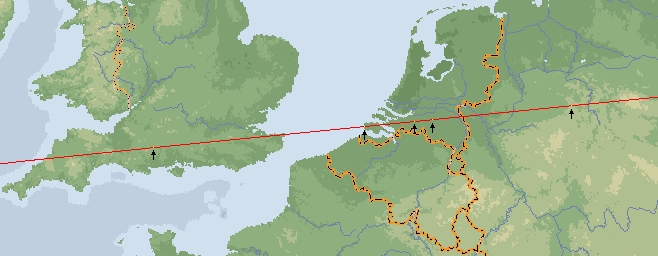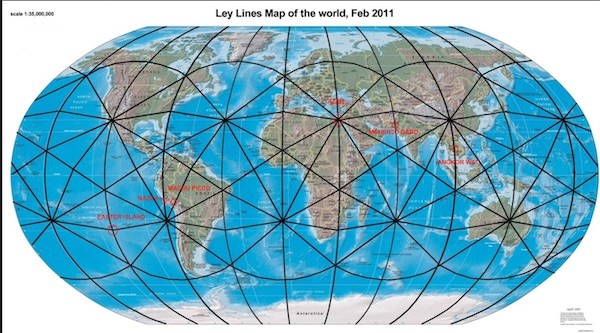LEYLINES
The first time I recognized a pattern in the landscape, happened in Wiltshire (England). Somebody showed me on a map of the region, the fact, that a straight line could be drawn, starting at Salisbury Cathedral, passing Old Sarum (a Norman-ford) and then crossing the neo-lithic monuments of Stonehenge, Avebury and beyond. That's how far my map went, but this “leyline” could be traced all across the English country-side.
Nowadays you can trace these leylines by connecting the churches. Most of the time they were build on ancient sites, of religious, pagan character. Often, Christian missionairies cut down holy oaks, to proof, that the pagan Gods didn't interfere and started building a (wooden) church on this “unholy” ground. Ironically the first churches were build using the holy oaks, home of demons and gods, as their main material.
But what if you draw a straight line from Easter Island to Gizeh and back to Easter Island again. It will shock you, how many important ancient sites are connected in this way.

Starting at Easter Island, the most isolated ancient, archeological site, we pass Nazca, Ollantay Tambo, Machu Pichu, Guzco, Mali (the Dogon Lands; a tribe which knew the Sirius-constellation long before it was officially discovered); Tassili N'jaher (the famous cave-paintings of space-visitors in Algeria), Siwa (the Amon-oracle, that was visited by Alexander the Great); Petra, the famous “hidden city” and mentioned in the Bible as a place where giants dwelled; Ur, one of the first cities in Mesopatamia; Persepolis, the core of Persian art and religion (burned down by Alexander's troops),

Mohendje Daro in Pakistan, where writings are unearthed that resemble those of Easter Island, next, 3 places where the Gods reside: Khajuraho (India), Pyay (Birma) and Sukothai (Thailand). The last monument we meet on our trip around the world, is the famous templecomplex of Aqngkor Wat in Cambodia.
Do you think, that this is all a coincidence? I don't. Even though the monuments date from different periods, they were all built on the remains and ruins of the foundations older, even more advanced cultures, who constructed Stonehenge, the Sfinx or the Borubudur. It gives our idea of global connections deeper meaning and it stretches the human history back to the Ice Age and possibly far further back; reaching into the solar system and beyond.


Geen opmerkingen:
Een reactie posten